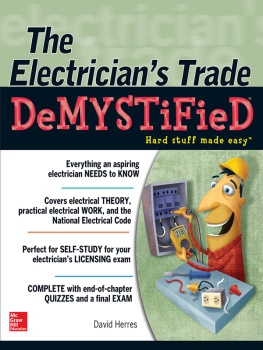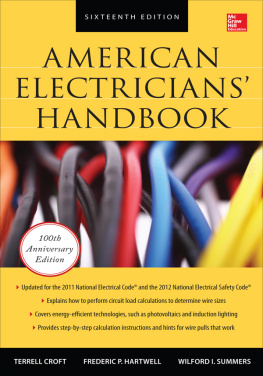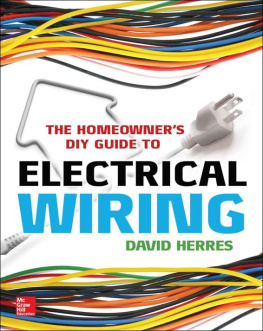This is book is dedicated to all of you up and coming electricians that are busting your asses every day on the job, studying to get further, researching, asking questions, watching videos, and engaging in forums. You are driven to excel at a lifelong craft that will provide a better life for you and your family. Keep doing good work my dude, and youll get therejust keep grinding.
-DS
Understanding The NEC Layout Part I Chapters
One thing that helps you understand the NEC is taking a birds-eye-view of how its laid out as a manual. The Chapters are not just randomly laid out as you may think theres a purpose in HOW it is laid out and why.
The 2017 NEC has a table of contents, 9 Chapters, 10 informational annexes, and an index - all of which serve a certain topic or purpose. Knowing the layout of these Chapters is crucial in being able to work through the book to find codes both on the job as well as in the testing center, while taking an exam. Lets take a look at it from above:
Table of Contents
Chapter 1 General
Chapter 2 Wiring and Protection
Chapter 3 Wiring Methods and Materials
Chapter 4 Equipment for General Use
Chapter 5 Special Occupancies
Chapter 6 Special Equipment
Chapter 7 Special Conditions
Chapter 8 Communications Systems
Chapter 9 Tables
Annex A Product Safety Standards
Annex B Application Information for Ampacity Calculation
Annex C Conduit and Tubing Fill Tables for Conductors and Fixture Wires of the Same Size
Annex D Examples
Annex E Types of Construction
Annex F Availability and Reliability for COPS and FPTs for COPS
Annex G Supervisory Control and Data Acquisition (SCADA)
Annex H Administration and Enforcement
Annex I Recommended Tightening Torque Tables from UL Standard 468A-B Annex J ADA Standards for Accessible Design
Index
Table of Contents and Index
All of that may seem overwhelming, but most of the Annexes are not going to be on the test in most states. Ive color-coded the above information because each item that is similarly colored can be thought of as having a combined purpose. For example, the table of contents and index are both just tools for navigating topics and keywords in the book. Theyre your maps essentially - they hold all of the key destinations and locations youre looking for in the book.
Chapters 1-4
Notice that Chapters 1-4 are combined into one conceptual group. These Chapters are rules that generally apply to all places and equipment youre going to run into. This is the bedrock/foundation of all of the code knowledge in the NEC and what youll rely on in most cases. These Chapters are standards for homes, apartments, banks, strip malls - normal, everyday places and situations that most electricians are going to come across on a daily basis.
Chapters 5-7
Chapters 5-7 are all grouped together as well, because these 4 Chapters are special cases (locations, equipment, situations) that supplement or modify information in Chapters 1-7. If youre in an environment where a lot of people assemble (like a concert), or in a corrosive environment (around large bodies of water), youll look in Chapters 5-7. Not just the location, but the equipment can be specialized as well. If youre working on equipment that is not standard air conditioners and water-heaters, such as cranes, welders, elevators, and x-ray equipment, youll look to Chapters 5-7 for these rules.
Chapters 8-9 and Annex C
The reason I have Chapters 8, 9, and Annex C grouped together is that, in most states, you may not be tested on these, but they may help you find information that can get you answers to test questions. They have similar information and functions. Chapter 8 applies to communications circuits, most of which apply to low voltage systems and are not required code. In Article 90.3, the NEC states, Chapter 8 covers communication systems and is not subject to the requirements of Chapters 1-7, except where the requirements are specifically reference in Chapter 8.
Chapter 9 is used mainly for conductor and conduit dimensions, and being able to figure out how many conductors can fit into what sized conduit. More specifically if youre trying to fit multiple differently sized conductors into a run of conduit. Annex C holds table after table of different conduits, sizes, and how many of the same sized conductors you can fit in whatever conduit youre working with. So Chapter 9 different sizes. Annex C same sizes. Keep in mind the values in the Annex C tables are based on the information in the Chapter 9 tables. Annex C is really a quick reference for us out in the field, because more often we use the same sized conductors in conduit, instead of differently sized conductors.
Now when youre looking for codes about installing receptacles near a pool, you know you can save time by not looking in Chapters 1-4. It has to be somewhere in Chapters 5-7. You also know its not in any of the Annexes. Once you dig around and start getting a feel for which Articles are in which Chapters, it really helps you understand how to navigate the NEC and quickly to find information.
***PRO TIP Get yourself a set of colored NEC approved tabs for your code book. These are allowed, in most states, to be installed in your code book so that you can quickly identify Chapters, tables, articles, and sections that are specific and used frequently. ***
Understanding The NEC Layout Part II Articles, Parts, Sections, and Sub-Sections
The next thing you need to wrap your head around is the meat and cheese of whats inside these Chapters. This information is also laid out purposefully, though itll seem like an unnavigable maze at times.
Articles
Articles are the main structure of each Chapter. For example, in Chapter 3 we have Articles 300, 310, 312, 314, and so on all the way to 399. There doesnt seem to be any recognizable convention as to why certain numbers are skipped or chosen, other than possibly leaving space for future code cycles. These articles are what youll need to pay a lot of attention to, as they are the more like sub-Chapters to each Chapter. There are a lot of articles in the NEC, and some Chapters have a ridiculous amount of them. The information can be a bit confusing, so the writers of the NEC came up with Parts.
Parts
Parts are in every Article, because a lot of topics differ wildly and need to be grouped together in a way that makes navigating the Article easier. We have Article 250, which covers all of grounding and bonding for the entire code book. Inside of it, there is so much information that there are 10 parts. These are roman numerals i.e. Part I, II, III, IV. These Parts let you know that there are very different topics in the Article in this case Grounding and Bonding. Part I is general grounding and bonding, whereas Part VIII is direct current systems and Part V is bonding and how it relates to several other Parts. All of these Parts correlate to the main Article 250 but each is a separate subject on its own. There is a great diagram in the 2017 NEC on page 70-104 Figure 250.1 that shows the breakup of the 10 Parts in Article 250 and how each differs.
Sections
This is where things start to get a bit hairy. Within each Article, we also have Sections. Each Section is a more specific situation that deals with the main Article. Some Articles have many sections, while others have very few. Some Examples of Sections are:
250.50 Grounding Electrode System
250.78 Common Grounding Electrode
250.97 Bonding for Over 250 Volts
In the above examples, were in Chapter 2, Article 250, Section 50, 78, and 97 respectively. But it gets deeper yet my friends.








